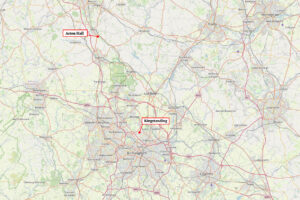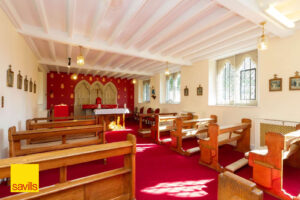A new era for Aston Hall, Stone
Archdiocese of Birmingham sells site to The St Barnabas Society
The Archdiocese of Birmingham is pleased to announce it has agreed, subject to contract, the sale of Aston Hall in Stone, Staffordshire, to The St Barnabas Society.
Aston Hall has been owned by the Archdiocese since 1959 and used as a guest house for priests and a home for retired and convalescent priests. It has an impressive Catholic history, most notably as the hiding place for the bones of St Chad, which were discovered under the altar in the Hall chapel, having been brought to Aston Hall from Lichfield Cathedral for safekeeping during the Reformation. In 1842, Blessed Dominic Barberi arrived from Italy and founded a Passionist noviciate at the Hall. In recent times the number of priests choosing to stay at Aston Hall had fallen to low single figures and at the time the final decision was taken to make the house available for sale there was only one priest in residence who was found accommodation closer to his family. At this level of occupancy, the current arrangements were not sustainable and for some time we have been searching for an appropriate buyer and new owner.
The Grade II listed property was designed by Edward Welby Pugin as a private house, though the site itself is much older.
The St Barnabas Society ‘is a registered charity which operates in Great Britain and Ireland. It exists to provide pastoral and financial help on behalf of the whole Catholic community to former clergy and religious of other Christian denominations and other world faiths, who are resident in Great Britain and Ireland, and who have been led by faith and conscience into the full communion of the Catholic Church’.
The Society intends to use Aston Hall as a new home for the Sisters of the Blessed Virgin Mary and its vision to make the Society more widely known within the Catholic Church. The rich Catholic history attached to the property will provide a solid foundation for its future development. There will also be investment in providing apartments for retired priests, with the Hall being used for retreats and meetings.
Fr Paul Martin, Director of the St Barnabas Society, said: “I am delighted that the Trustees of the Archdiocese of Birmingham have agreed to the offer of the St Barnabas Society for the purchase of Aston Hall, in Staffordshire, as a new home for the Sisters of the Blessed Virgin Mary and our vision to make the Society more widely known within the Catholic Church.
“We are confident that Aston Hall will provide for all our needs and that the rich Catholic history attached to this property will provide a solid foundation for their future development.
“May the intercession of St Chad, whose relics were hidden there at the time of the Reformation, of Blessed Dominic Barberi, who made his home there and used it as a centre for his missionary activity, and of the Venerable Ignatius Spencer, who began his novitiate as a Passionist there, help us as we move the Society forward to a fruitful future. May that same intercession help the St Barnabas Society to extend the sphere of its activity and, in doing so, assist the Archdiocese of Birmingham and the wider Church in bringing the riches of the Catholic Faith to our society in the 21st Century.”
Archbishop Bernard Longley said: “I am delighted that a sale has been agreed with The St Barnabas Society and that Aston Hall will remain within Catholic ownership. The work of The St Barnabas Society reflects many of the priorities of our Diocesan Vision and I am grateful that the Sisters of the Blessed Virgin Mary have found a new home for their apostolate of prayer within the Archdiocese. It is a blessing that Aston Hall will continue to offer accommodation for retired clergy and to welcome those who come on pilgrimage to seek the intercession of Blessed Dominic Barberi.”
 The Sisters of the Blessed Virgin Mary are a community of religious currently based in a house in Kingstanding in Birmingham. They are members of the Ordinariate and follow the Benedictine Rule. The Revd Mother Winsome was the keynote speaker at the Ordinariate conference in Chingford in May, and mentioned the dilapidated state of their current inner-city house and the hope and prayer for a new home. The Ordinariate and the Sisters thank God that this has become possible.
The Sisters of the Blessed Virgin Mary are a community of religious currently based in a house in Kingstanding in Birmingham. They are members of the Ordinariate and follow the Benedictine Rule. The Revd Mother Winsome was the keynote speaker at the Ordinariate conference in Chingford in May, and mentioned the dilapidated state of their current inner-city house and the hope and prayer for a new home. The Ordinariate and the Sisters thank God that this has become possible.
Historic England have a potted history of the building:
Aston Hall is a Grade II listed property designed as a private house by Edward Welby Pugin in 1855 for Father Edward Huddleston, and incorporating an earlier wing and material from a convent designed by CF Hansom.
The site is ancient with a large moat (now dry). In the sixteenth century the property passed to the Heveningham family and from them to the Simeon family. In about 1757 Sir James Simeon built a family mausoleum to the south west of the moat which survives (Grade II). The estate passed to the Roman Catholic Weld family who commissioned a design from John Tasker in about 1798. This house was given to the English Franciscans to serve as a noviciate and Bridgettine nuns were in residence from 1829 to 1837. In 1838 the bones of St Chad were discovered under the altar in the Hall chapel, having been brought to Aston Hall for safe keeping from Lichfield Cathedral during the Reformation. In 1842 Dominic Barberi arrived from Italy and founded a Passionist noviciate at the Hall. A small convent and chapel with a courtyard plan was designed and built for him by C F Hansom in 1847 to 1849. Barberi was responsible for receiving John Henry Newman into the Catholic Church in 1845 and was himself beatified in 1963.
Following Barberi’s death in 1849 the Passionists gave up the mission and the site was bought in 1855 by The Reverend Canon Edward Huddleston who employed EW Pugin to rebuild the Hall. It was one of his first independent commissions following the death of his father, AWN Pugin. This, the present Aston Hall, appears to include an earlier range which may have formed part of Hansom’s convent buildings. It was also extended in 1912 when the present dining room was built on the site of a former conservatory. Hansom’s convent building was built over a part of the moat and proved unstable. It was demolished in the 1880s and the present church was built to the north west of the moat. It is believed that the salvaged features from the earlier convent were re-used in the new Catholic parish church and formed part of the rear wing of Pugin’s house of 1855.
From 1959 the house has been owned by the Birmingham Roman Catholic Diocese and used as a home for retired and convalescent priests.
The sale was handled by Savills who took a number of photographs, notably of the exterior and the chapel:









 Posts
Posts